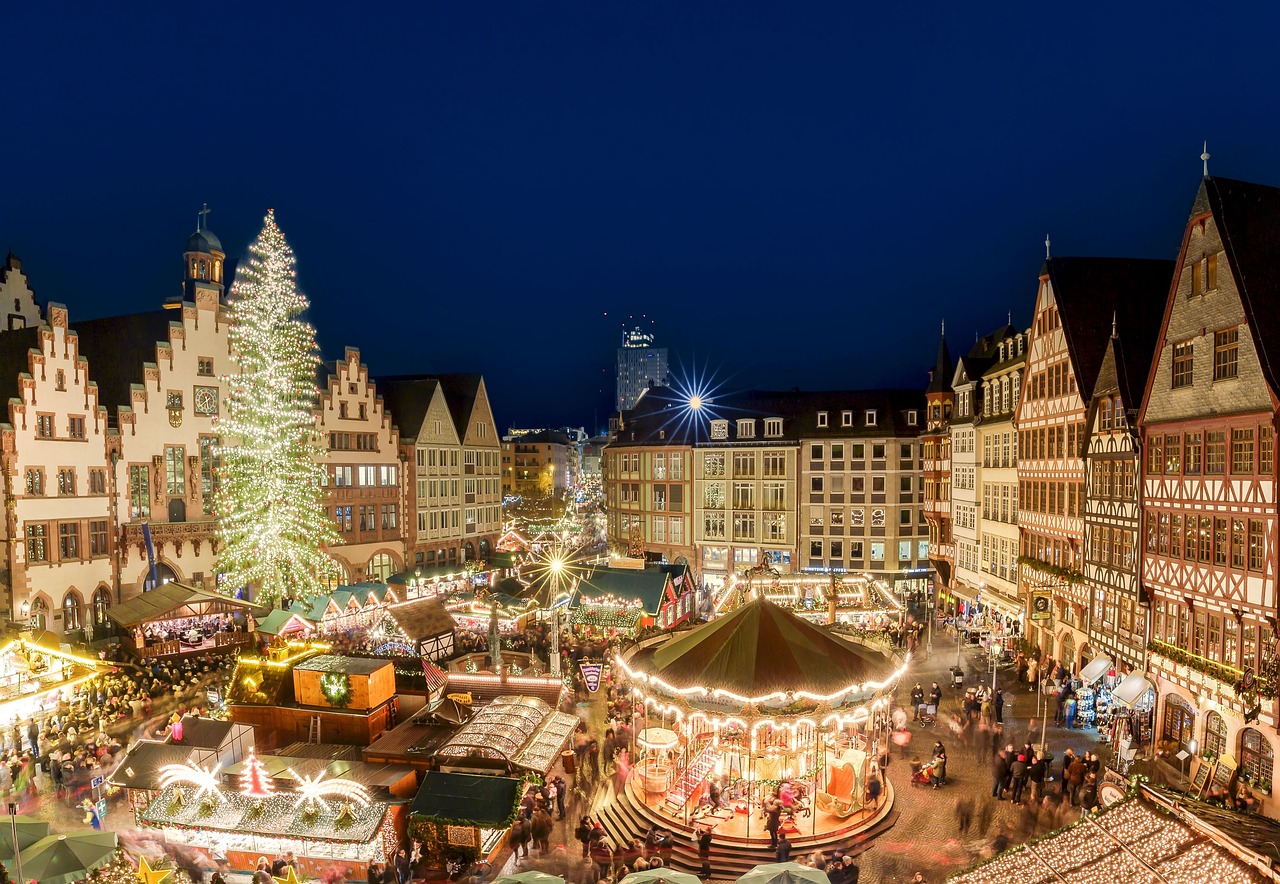Top Christmas Market Traditions in Germany
By Isabel Eva Bohrer

|
|
Traditional Christmas market in Frankfurt, Germany (running since 1393).
|
Christmas: For a large population of the world, it is the most wonderful time of the year. The further north you go, it is also the coldest. Combating the cold in December has long been an issue for inhabitants of northern countries. Before the advent of heated department stores and malls, Christmas markets flourished to keep shoppers warm and bring people together.
Huddling around fires and sipping Glühwein, which in German literally means “glow-wine”, people — as far back as the fourteenth century — would come to the outdoor Christmas markets to purchase goods that would keep them comfortable throughout the long winters. They bought furs, hats, coats, and anything else to keep out the wind and snow. Alongside items of clothing, handicrafts such as woven baskets or artisan toys were also sold. In order for visitors and shoppers to keep energized as they perused the various stands, baked goods, simple hot meals and the above mentioned Glühwein were sold as well. The Christmas market was, in part, to warm up and keep warm.
What Remains of 14th Century Traditions?
Over time, the markets developed into a key element leading up to Christmas Eve. Every year, tourists from all over the world flock to Germany to visit the markets. It appears that one hears more English, Spanish, and Japanese spoken than traditional German dialects. With its glowing lights, the Christmas market has become commercialized.
However, that is not to say that all traditions have been undermined. First of all, it is worth mentioning that though combating the cold is a common denominator in the origin of most Christmas markets, there are hundreds of different markets in and around Germany. Some are more famous than others, some are larger than others, and some are more traditional than others. They may even have different names, ranging from Weihnachtsmarkt (Christmas market) to Christkindlmarkt (the Christkindl is the angel that brings the presents on Christmas eve) to Adventmarkt (Advent market).
For example, Christkindlmarkt in Munich at Marienplatz, in the main square, is said to originate in the 14th century with the so-called Nikolausmarkt (Santa Claus market) traditions. But under the influence of Protestantism came the transition from the Nikolaus to the Christkind as the one who brings the gifts. This transition occurred in the sixteenth century in the cities of Nürnberg and Straßburg: where the Nikolausmarkt became the Christkindlmarkt.
In fact, Nürnberg, which hosts one of the most famous Christmas markets in Germany, the figure of a Christkind, represented by a young girl, has accompanied the fair from its very beginnings. Many markets, moreover, include a representation of the nativity scene, called the Krippe. In Munich, there is an entire market whose name is just devoted to the manger: the Kripperlmarkt at the Rindermarkt square.
In terms of preserving traditions, a special mention must go to the Mittelaltermarkt — also in Munich (specifically at the Wittelsbacherplatz square). One of the most recent additions to the Munich fair scene, the Mittelaltermarkt, which literally means “medieval market,” showcases traditional goods sold at reconstructions of medieval stands. Even the vendors are dressed in medieval clothes.
In addition to seeking out the time-honored Krippe representations, here are some tips for the tourists in search of past traditions:
-
Eat like the locals. Some markets such as those in Lucerne will have a Chinese food chain offering udon. But if you are coming to see and celebrate the real deal, try the Lebkuchen (typical baked goods) and Rostbratwürstchen (grilled sausages) from Nürnberg and the typical Maroni (chestnuts) sold at almost all German, Austrian, and Swiss markets. At the latter, a Raclette (bread dipped in cheese) will surely warm you up as well.
-
Drink like the locals. Glühwein and Eierlikör (eggnog liquor) for adults and Kinderpunsch (fruity “glühwein” without alcohol) for the children: there’s something for everyone.
Tips for Visiting Markets in Germany:
-
Dress warmly. Try to keep in mind the initial purpose of the markets. No need to win a prize for elegant sandals as the point is not to catch the flu. Wearing ski pants has even become an option for some, especially little kids.
-
Book tickets and hotels early. Cities like Nürnberg and Munich are popular around this time of year and money can be saved by purchasing tickets in advance.
-
Weekends are crowded. Saturday and Sunday is when not only the tourists but also the locals visit the markets. If you are going with a big group, make sure to agree on a meeting point in case someone gets lost. A good option for those in Munich: the Christkindlmarkt im Englischen Garten am Chinesischen Turm which, since it is in the park, is not only very beautiful, but also tends to be less crowded.
-
Try to learn a bit of the local language. Though most people will be able to respond in English, it is always useful to learn a few local words. Ordering food and drinks will be much easier and likely more enjoyable when knowing a few basics.
-
Have fun! Most of all, the idea is to have a good time with friends and family. Enjoy Christmas and relax! A mug of Glühwein will surely do the trick.
Isabel Eva Bohrer is the Director and Founder of ROOSTERGNN Global News Network, a non-profit news agency.
|
